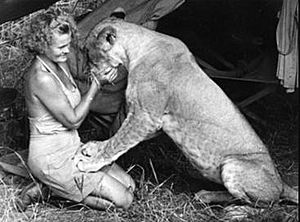Joy Adamson facts for kids
Quick facts for kids
Joy Adamson
|
|
|---|---|

Adamson with Elsa the lion c. 1958
|
|
| Born |
Friederike Victoria Gessner
20 January 1910 Troppau, Austrian Silesia, Austria-Hungary, now Opava, Czech Republic
|
| Died | 3 January 1980 (aged 69) Shaba National Reserve, Kenya
|
| Resting place | Meru National Park |
| Occupation |
|
| Spouse(s) |
Sir Viktor Von Klarwill
(m. 1935; div. 1937)Peter René Oscar Bally
(m. 1938; div. 1944)George Adamson
(1944–1980) |
| Writing career | |
| Language | English |
| Period | 1960–1980 |
| Genre | Nonfiction |
| Subjects | Animals, African culture, nature |
| Years active | 1960–1980 |
| Notable work | Born Free |
|
|
|
Friederike Victoria "Joy" Adamson (born Gessner; 20 January 1910 – 3 January 1980) was a famous naturalist, artist, and author. She is best known for her book Born Free. This book tells the amazing story of how she and her husband raised a lion cub named Elsa.
Born Free became very popular and was translated into many languages. It was even made into an Academy Award-winning movie. In 1977, Joy Adamson received a special award from Austria for her work in science and art.
Contents
Joy Adamson's Life Story
Joy Adamson was born in Troppau, which is now Opava in the Czech Republic. She was one of three daughters. When she was 10, her parents divorced, and she went to live with her grandmother. Joy felt that her grandmother taught her many good things.
She grew up near Vienna and studied music, sculpting, and medicine. As a young adult, she thought about becoming a concert pianist or working in medicine.
Marriages and Moving to Kenya
Joy Adamson married three times. Her first marriage was in 1935. In 1937, she moved to Kenya, a country in Africa. There, she met and married a botanist named Peter Bally in 1938. Peter encouraged her to keep drawing and painting the plants and animals around her.
Later, in the early 1940s, she met her third husband, George Adamson. He was a senior wildlife warden. They married in 1944 and made their home together in Kenya.
Elsa the Lioness
Joy Adamson is most famous for her work with Elsa. In 1956, George Adamson, while working as a game warden, had to shoot a lioness that charged him. He later found out she was protecting her cubs. Joy and George took the cubs home. Two of the cubs were sent to a zoo, but they decided to raise the smallest one, Elsa, themselves.
Instead of sending Elsa to a zoo, the Adamsons wanted to set her free. They spent many months teaching her how to hunt and live on her own in the wild. Their efforts were successful! Elsa became the first lioness to be released back into the wild and still stay in contact with humans. She was also the first known released lion to have her own cubs. The Adamsons kept their distance from Elsa's cubs, only getting close enough to take pictures.
In January 1961, Elsa sadly died from a disease caused by a tick bite. Her three young cubs started causing trouble by killing farm animals. The Adamsons worried the farmers might harm the cubs. They managed to capture the cubs and move them to Serengeti National Park in nearby Tanzania, where they would be safe.
Life After Elsa
After Elsa died, Joy and George Adamson's interests began to go in different directions. George wanted to keep working with lions, while Joy wanted to work with cheetahs. They decided to live apart but remained good friends. They spent every Christmas together.
Joy used her notes and George's journals to write Born Free, telling Elsa's story. It was published in 1960 and quickly became a bestseller. The book's success was partly due to the amazing story of Elsa and the many photographs included. Readers could see pictures of Elsa's life, right up to her release.
Conservation Work
Thanks to the popularity of Born Free, Joy Adamson spent the rest of her life raising money for wildlife conservation. She wrote two more books about Elsa: Living Free, which was about Elsa as a mother, and Forever Free, which told the story of her cubs. Joy shared the money from her books with different conservation projects.
For her last 10 years, Joy Adamson traveled the world. She gave speeches about the dangers faced by wildlife in Africa. She also worked to rehabilitate other wild animals. She raised a cheetah named Pippa, who was also released into the wild and had four litters of cubs. Joy wrote two books about Pippa and her cheetah family. Later, she also raised an African leopard cub named Penny, who had two cubs.
Joy Adamson was also a talented artist. She created over 500 paintings and drawings. These included portraits of local people for the Kenyan government and detailed drawings of plants for books about East African flora. She also painted animals, including Elsa and Pippa.
Films About Joy Adamson's Work
- Born Free
- Living Free
- Elsa & Her Cubs (1971)
- Joy Adamson – About the Adamsons
- Joy Adamson's Africa (1977)
- The Joy Adamson Story (1980)
See also
 In Spanish: Joy Adamson para niños
In Spanish: Joy Adamson para niños

